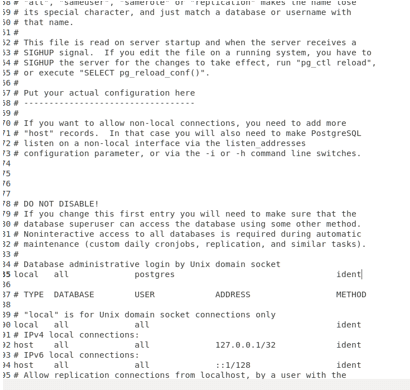

#LIST USER POSTGRES FULL#
When the list is longer than N, (at least in 9.3), warning with list of privileges is collapsed, but you still can find it full in logs. Query below returns list of users in current database. PostgreSQL user attributes string in the format: CREATEDB,CREATEROLE,SUPERUSER. same for user defined types, domains and so on - using "+" after the meta-command will show you privileges if applicable.Ī little extreme way to check the privileges is dropping the user in transaction, e.g.: s=# begin drop user x ĮRROR: role "x" cannot be dropped because some objects depend on it
#LIST USER POSTGRES MANUAL#
I deliberately skip function and language privileges here, found in psql manual as barely manipulated (and if you do use those privileges you wont come here for an advise). \du+ for roles with login and \dg+ for roles without - will have a filed "Member of" where you find roles granted to roles. Īlso mentioned above, but not found with word "privileges" on the manual page: Are there some approaches to fetch order history efficiently in this case. Lets say i have sharded data based on orderid and now if i want to show order history for a userid, it would require to fetch data from all shards to get all orders, which in turn seems to be costly operation. \l List the databases in the server and show. Optimising fetching of data from different shards for a user. Use the label applicationspilo to filter and list the label spilo-role to see when the master is promoted and replicas get their labels. This can be done with the \connect meta-command or its shortcut \c.\dp Lists tables, views and sequences with their Often, when working with servers that manage multiple databases, you’ll find the need to jump between databases frequently. Once you have created another database you will want to switch to it in order to create tables and insert data. Use the SELECT statement to query the user information from the pgcatalog. postgres is the default database you will connect to before you have created any other databases. Use du or du+ PostgreSQL Show Databases command to list all users in the current database server. template0 and template1 are skeleton databases that are or can be used by the CREATE DATABASE command. Most Postgres servers have three databases defined by default: template0, template1 and postgres. They are the persona that users adopt within the database. Creating PostgreSQL users At the command line, type the following command as the servers root user: You can now run commands as the PostgreSQL superuser. UTF - 8 | = c / postgres + | | | | | postgres = CTc / postgres ( 4 rows ) Switching Databases PostgreSQL roles are a combination of the ideas of users and groups into a single, flexible entity. UTF - 8 | = c / postgres + | | | | | postgres = CTc / postgres template1 | postgres | UTF8 | en_US. UTF - 8 | template0 | postgres | UTF8 | en_US.

Postgres =# \ l List of databases Name | Owner | Encoding | Collate | Ctype | Access privileges -+-+-+-+-+- postgres | postgres | UTF8 | en_US. To view all of the defined databases on the server you can use the \list meta-command or its shortcut \l. Each database is stored as a separate set of files in its own directory within the server’s data directory. Listing DatabasesĪ single Postgres server process can manage multiple databases at the same time. They are denoted by a backslash and then followed by the command and its arguments. Meta-commands are commands that are evaluated by psql and often translated into SQL that is issued against the system tables on the server, saving administrators time when performing routine tasks. In addition to being able to submit raw SQL queries to the server via psql you can also take advantage of the psql meta-commands to obtain information from the server.
#LIST USER POSTGRES HOW TO#
In this tutorial, we will learn how to answer these key questions from the command line using psql. This involves asking questions like “Which databases reside on this server?” or “What tables are stored in a particular database on this server?”. One of the most common tasks a database administrator performs is simply getting familiar with the environment. However, now I have two problems: how to see which UDTs have been defined how to see the columns defined within these UDTs Unfortunately, I couldn't find anything on that in the PostgreSQL documentation. However, Postgres itself comes bundled with a powerful command line tool called psql which is great for those familiar with the terminal or looking to script administration tasks. 33 I've created a few new UDTs in PostgreSQL. When it comes to administering Postgres databases, there’s a wide variety of third party tools available such as SQL Workbench/J or pgAdmin III.


 0 kommentar(er)
0 kommentar(er)
